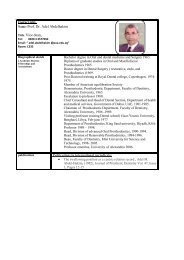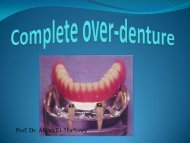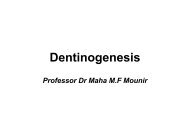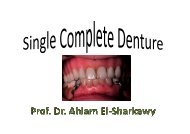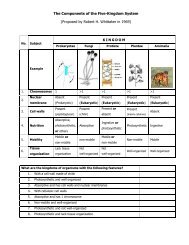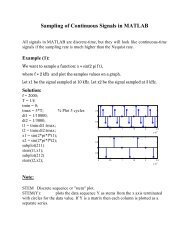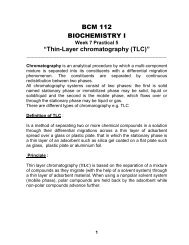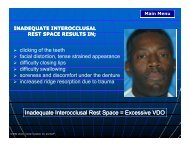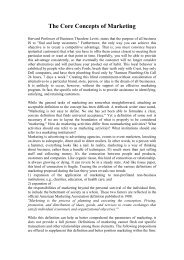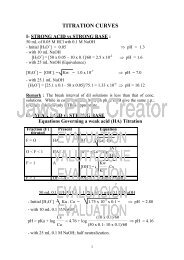1- common complaint - Pharos University in Alexandria
1- common complaint - Pharos University in Alexandria
1- common complaint - Pharos University in Alexandria
Create successful ePaper yourself
Turn your PDF publications into a flip-book with our unique Google optimized e-Paper software.
Prof.Dr. Ahlam El-Sharkawy<br />
Professor of prosthodontics.<br />
<strong>Pharos</strong> university.<br />
prpp
Denture patients can be classified<br />
<strong>in</strong>to three groups:<br />
• The first group : Accept anyth<strong>in</strong>g even badly<br />
constructed denture.<br />
• The second group: Hard to please even with<br />
well constructed denture<br />
• .<br />
• The third group : Easily pleased and satisfied<br />
with well constructed denture.
Compla<strong>in</strong>ts<br />
Common<br />
Un<strong>common</strong>
Common Compla<strong>in</strong>ts<br />
1.Pa<strong>in</strong><br />
2. Esthetics<br />
3. Inefficiency<br />
4.Poor Retention<br />
5. Instability<br />
6. Clatter<strong>in</strong>g of teeth<br />
7. Nausea<br />
8. Discomfort<br />
9. Altered speech<br />
10. Bitt<strong>in</strong>g the cheek and<br />
tongue<br />
11. Food under the denture
Un<strong>common</strong> Compla<strong>in</strong>ts<br />
1. Allergy<br />
2. Whistl<strong>in</strong>g<br />
3. Lisp<strong>in</strong>g<br />
4. Ear ache<br />
5. Loss of taste sensation<br />
6. Peculiar taste<br />
7. Defensive tongue<br />
8. Burn<strong>in</strong>g of mouth
A) PAIN
Causes of pa<strong>in</strong><br />
• 1- Over extended periphery.<br />
• 2- poor fit.<br />
• 3- Insufficient relief.<br />
• 4-Incrrect centric relation.<br />
• 5- Other occlusal error.<br />
• 6-Teeth outside the ridge.<br />
• 7- Reta<strong>in</strong>ed root or un-erupted tooth.<br />
• 8- V shaped ridge.
Causes of pa<strong>in</strong>.<br />
• 9- Mental foramen.<br />
• 10-Irregular resorption.<br />
• 11- Pathological conditions.<br />
• 12- Rough fitt<strong>in</strong>g surface.<br />
• 13- <strong>in</strong>fection with monilia.<br />
• 14- Swallow<strong>in</strong>g and sore throat.<br />
• 15- Undercuts.
1- Overextension of the periphery<br />
• Most <strong>common</strong> cause of pa<strong>in</strong>.<br />
• Incorrect mold<strong>in</strong>g of the impression .<br />
• Visible <strong>in</strong> the mouth as a red l<strong>in</strong>e, an area of<br />
hyperemia or an ulcer.
Visual &digital<br />
exam<strong>in</strong>ation<br />
Indelible<br />
pencil<br />
Disclos<strong>in</strong>g<br />
wax
1- Overextension of the periphery<br />
• Treatment: mark with <strong>in</strong>delible pencil or use<br />
disclos<strong>in</strong>g wax.
2- Poor fit<br />
• The movement of denture rubb<strong>in</strong>g the<br />
mucosa caus<strong>in</strong>g pa<strong>in</strong> and patches of redness.
2- Poor fit<br />
• Treatment: new denture, rel<strong>in</strong><strong>in</strong>g us<strong>in</strong>g soft<br />
l<strong>in</strong>er or rebas<strong>in</strong>g
3- Insufficient relief<br />
Poor base adaptation<br />
Fulcrum on bony structures<br />
Treatment: apply PIP and<br />
relief pressure areas.
4- Incorrect jaw relations<br />
a. Wrong antero-posterior relationship<br />
Treatment: If slight not more than ¼ of cusp it<br />
can be corrected by gr<strong>in</strong>d<strong>in</strong>g the mesial planes<br />
of the upper cusps and distal planes of lower<br />
cusps.<br />
- If gross, new dentures will be required.
B- Uneven pressure.<br />
• Treatment:<br />
• If detectable with a spatula, a new lower<br />
denture.<br />
• If detectable with celluloid strips, selective<br />
gr<strong>in</strong>d<strong>in</strong>g us<strong>in</strong>g articulat<strong>in</strong>g paper
Increased Vertical Dimension<br />
Excessive VD<br />
• Sorness over entire ridge .<br />
• Muscle/jo<strong>in</strong>t pa<strong>in</strong><br />
• Denture teeth clatter dur<strong>in</strong>g<br />
eat<strong>in</strong>g and talk<strong>in</strong>g.<br />
• Esthetic <strong>compla<strong>in</strong>t</strong>s:
Decreased Vertical Dimension<br />
Effects of excessively reduc<strong>in</strong>g the<br />
vertical dimension:<br />
1-Inefficiency.<br />
2- Cheek bit<strong>in</strong>g.<br />
3- appearance.<br />
4- soreness at the corners of the<br />
mouth(Angular cheilitis)<br />
5- Costen’s syndrome
Costen’s syndrom
Costen’s Syndrom<br />
1- Vestibulo – cochlear Nerve ( 8 th cranial nerve)<br />
2- Chorda Tympani Nerve(Branch from Facial Nerve-7th c.n)<br />
3-Auriculo-Temporal Nerve(Branch from Mandibular n.<br />
which is Branch from Trigem<strong>in</strong>al n. 5th c.n)
I – Otological Symptoms :<br />
Pressure on Vestibulo-Cochlear nerve.<br />
1- Vertigo.<br />
2-T<strong>in</strong>nitus<br />
3- Mild Catarral Deafness
II – Oral Symptoms<br />
Pressure on Chorda Tympani<br />
1- Burn<strong>in</strong>g Sensation <strong>in</strong> the ant. 2/3 of<br />
the Tongue<br />
2- Metalic Taste<br />
3- Xerostomia
III – T.M.J and Peri auricular Symptoms<br />
Pressure on Auriculo-temporal n.<br />
1- Pa<strong>in</strong> <strong>in</strong> T.M.J<br />
2-Pa<strong>in</strong> <strong>in</strong> the Ear<br />
3-Pa<strong>in</strong> <strong>in</strong> the Periauricular Region<br />
4- Xerostomia.
5- other occlusal errors<br />
• Cuspal <strong>in</strong>terference<br />
• Disharmony between centric relation & centric<br />
occlusion<br />
• 1-Dragg<strong>in</strong>g of mucosa with retentive denture<br />
• 2-Instability with un-retentive denture<br />
• Treatment:<br />
• Articulat<strong>in</strong>g paper &selective gr<strong>in</strong>d<strong>in</strong>g<br />
• Gr<strong>in</strong>d<strong>in</strong>g paste<br />
• Remount<strong>in</strong>g<br />
• New denture
6- Teeth outside the ridge<br />
• 1-Occlusal contact not<br />
centered over ridge<br />
• 2-Tilt<strong>in</strong>g forces cause<br />
displacement.<br />
3-Abrasion, ulceration<br />
<strong>in</strong> the buccal sulcus<br />
• 4-Cheek bit<strong>in</strong>g
7- Reta<strong>in</strong>ed root or unerupted tooth<br />
• Well fit denture will stimulate eruption of<br />
unerupted teeth<br />
• Treatment: relief or extraction and rel<strong>in</strong>e
8- V- shaped ridge<br />
• Usually associated with lower denture…<br />
pressure dur<strong>in</strong>g mastication press<strong>in</strong>g m.m.<br />
aga<strong>in</strong>st a sharp ridge of bone.<br />
• Treatment: relief or alveoplasty & rel<strong>in</strong>e
9- Mental foramen<br />
• Pressure on the mental foramen<br />
the foramen.<br />
Relief over
10- Irregular resorption<br />
• Sharp spicules of bone<br />
• Treatment: alveolectomy & rel<strong>in</strong><strong>in</strong>g
11- Pathological condition<br />
• Usually diagnosed & treated before new<br />
denture construction
12- Rough fitt<strong>in</strong>g surface<br />
• Small pimples where material forced <strong>in</strong>to<br />
small air bubbles of model<br />
• Treatment: remove the roughness
13- Infection with monilia albicans<br />
• Acute red <strong>in</strong>flammation term<strong>in</strong>at<strong>in</strong>g at<br />
borders of denture<br />
• Low prote<strong>in</strong> & vitam<strong>in</strong> diet<br />
• Treatment:<br />
• fungicide such nystat<strong>in</strong>e<br />
• Remove denture at night<br />
• Diluted hypochlorite
14- Swallow<strong>in</strong>g & sore throat<br />
• Overextension on soft palate<br />
• Excessive pressure <strong>in</strong> hamular notch<br />
• Overextension disally <strong>in</strong> l<strong>in</strong>gual pouch
15- Undercuts<br />
• Insert<strong>in</strong>g & remov<strong>in</strong>g denture is gett<strong>in</strong>g<br />
pa<strong>in</strong>ful<br />
• Treatment:<br />
• Insert this side first<br />
• Cut away from fitt<strong>in</strong>g surface but not height<br />
• Use of resilient l<strong>in</strong>er or alveoplasty
B) ESTHETICS
1- Nose & ch<strong>in</strong> approximation<br />
• Reduce vertical dimension with excessive<br />
freeway space<br />
• Treatment: rel<strong>in</strong>e one or both dentures or<br />
new one
2- Cheeks & lips fall<strong>in</strong>g <strong>in</strong><br />
• Lack of tone of facial muscles<br />
• Lack of support by teeth & alveolar ridges<br />
• Treatment:<br />
build<strong>in</strong>g out of upper denture to compesate for<br />
the loss muscular tone.
3-Angular cheilitis<br />
• Loss of vertical dimension<br />
• Secondary <strong>in</strong>fection<br />
• Treatment:<br />
• Increase vertical dimension<br />
• Correct position of anterior teeth<br />
• Provide sufficient support for angles of mouth<br />
by denture flanges
4- colour, size & position of anterior<br />
teeth<br />
a- Colour and size<br />
b- position.<br />
• Too dark or yellow, too large or small teeth<br />
• Irregularities pt wishes to reproduce
5- Amount of tooth show<strong>in</strong>g<br />
• Too much or too little show<strong>in</strong>g<br />
• Treatment: remake
6- General dissatisfaction<br />
• Middle aged women<br />
• Both pt & dentist should participate activities<br />
• Satisfy pt dur<strong>in</strong>g try <strong>in</strong> stage
C) INEFFICIENCY
1- Inability to eat anyth<strong>in</strong>g<br />
• Denture wearer for first time<br />
• Impatient<br />
• Psychological approach
2- Inability to eat meat<br />
• Flatten<strong>in</strong>g of cusps<br />
• Cuspless posterior teeth<br />
• Overclosure with decresed muscle efficiency<br />
• Unbalanced occlusion<br />
• Cuspal <strong>in</strong>terference<br />
• Inexperience
3- Denture dislodged by eat<strong>in</strong>g<br />
• Cuspal <strong>in</strong>terference<br />
• Unbalanced occlusion<br />
• Upper teeth outside the ridge.<br />
• Treatment.<br />
• remake
4- Insufficient tongue space<br />
• Lower denture move dur<strong>in</strong>g eat<strong>in</strong>g<br />
• Remake, allow<strong>in</strong>g more tongue space, us<strong>in</strong>g<br />
narrower posterior teeth<br />
Tongue
Tongue and cheek bit<strong>in</strong>g<br />
Tongue bit<strong>in</strong>g may be due to;<br />
1. the artificial teeth positioned too far l<strong>in</strong>gually.<br />
2. the occlusal plane is too low.<br />
3. enlarged hypertroghic tongue.
Tongue and cheek bit<strong>in</strong>g<br />
Cheek bit<strong>in</strong>g may be due to;<br />
1. sett<strong>in</strong>g of teeth buccally.<br />
2. lack of posterior overjet.<br />
3.loss of tone of cheek<br />
musculature with age.
5- Periphery overextended<br />
• Commonest place is region of l<strong>in</strong>gual pouch<br />
• Treatment:<br />
• Reduce overextension.
6- Inexperience<br />
• Bit<strong>in</strong>g : function of anterior teeth<br />
• Chew<strong>in</strong>g: function of posterior teeth<br />
• careful Explanation to the patient.
D) POOR RETENTION
1- When open<strong>in</strong>g mouth<br />
a. Overextension<br />
b. Tight lips<br />
c. Tongue cramped<br />
d. Underextension<br />
e. Lack of peripheral seal<br />
f. Lack of saliva or a very<br />
th<strong>in</strong> watery saliva
1- When open<strong>in</strong>g mouth<br />
Tight lips.<br />
A. Remake with the lower anterior teeth set<br />
more l<strong>in</strong>gually, with a labial concavity on the<br />
denture & with maximum extension <strong>in</strong><br />
the region of the retromolar pad.
2- When cough<strong>in</strong>g or sneez<strong>in</strong>g<br />
• Expla<strong>in</strong> that there is a movement when<br />
pressure of air <strong>in</strong> mouth is greater than<br />
atmospheric pressure<br />
• Peripheral seal broken<br />
• Unusual movement
E) INSTABILITY
Causes of <strong>in</strong>stability<br />
• Poor retention<br />
• Unbalanced occlusion<br />
• High occlusal plane<br />
• Teeth outside ridge<br />
• Teeth not <strong>in</strong> neutral zone<br />
• Unrelieved median raphe
f) Clatter<strong>in</strong>g teeth<br />
• Too great a vertical height<br />
• Gross cuspal <strong>in</strong>terference
G) NAUSEA<br />
Light or <strong>in</strong>termitted contact on soft palate or back<br />
of tongue
1- Denture slightly overextended<br />
• Intermittent contact with denture<br />
• Observe relation of posterior border to<br />
vibrat<strong>in</strong>g l<strong>in</strong>e<br />
• Remove excess
2- Denture underextension<br />
• Intermittent contact: denture mov<strong>in</strong>g ow<strong>in</strong>g<br />
to <strong>in</strong>adequate air seal<br />
• A palpable ridge: the edge detected by<br />
dorsum of tongue<br />
• Extend denture to vibrat<strong>in</strong>g l<strong>in</strong>e & post dam
3- thick posterior border<br />
• Dorsum of tongue irritated by thick edge<br />
• Th<strong>in</strong> down post. border
h) discomfort<br />
• Careful comparison with the old denture will<br />
give a clue to the cause<br />
1. Cramped tongue space<br />
2. Altered vertical height<br />
3. Altered occlusal plane<br />
• Pt should be encourage to preserve several<br />
weak
i) Altered speech<br />
• Temporarily<br />
• Overcome by read<strong>in</strong>g loud<br />
• Remake with concern thickness of palate &<br />
anterior teeth position
1- labial Sound<br />
2- Dental Sound<br />
3-Labio-dental Sound<br />
4-L<strong>in</strong>guo-dental Sound<br />
5- L<strong>in</strong>guo Palatal Sound
-It results from contact between upper<br />
and<br />
-lower Lips to pronounce-: [ B,P,M]
-Result from Relation Between<br />
Incisal Edge Of Upper ant. Teeth<br />
and Lower ant. Teeth to<br />
Pronounce ( S )
Result from Contact Between Lower<br />
Lip and Incisal Edge of Upper ant.<br />
Teeth to Pronounce ( F , V )
Result from Contact Between Tip<br />
of Tongue and Incisal Edge of<br />
Upper anterior Teeth to Pronounce<br />
( Th )
-Results from :<br />
A- Contact Between Tip of the Tongue<br />
and ant. Part of the palate to<br />
Pronounce ( T , D )<br />
B- Contact Between Tip of the Tongue<br />
and Middle Part of the Palate to<br />
Pronounce ( H )
Lisp<strong>in</strong>g<br />
Premature contact between tongue & ant.<br />
Teeth<br />
1. Increased vertical dimension<br />
2. Increased denture thickness<br />
3. Narrow arch space<br />
4. Anterior teeth too palatally<br />
Reduce <strong>in</strong>traoral air volume
Whistl<strong>in</strong>g<br />
.<br />
Failure of contact between tongue and<br />
anterior teeth<br />
1-Decreased vertical dimension<br />
1. -Increased overjet<br />
2. -Posterior teeth buccally<br />
3. Increase <strong>in</strong>tra oral air volume
j) Bit<strong>in</strong>g the cheek & tongue<br />
a) Insufficient overjet<br />
b) Reduced vertical height
k) Food under denture<br />
• Maximum cover<strong>in</strong>g & adequate peripheral<br />
seal
2- Un<strong>common</strong> <strong>compla<strong>in</strong>t</strong>
Allergy<br />
• Burn<strong>in</strong>g sensation<br />
• Mucosa slightly <strong>in</strong>flamed & red <strong>in</strong> color<br />
• New denture <strong>in</strong> another material
Ear ache<br />
• Pa<strong>in</strong> <strong>in</strong> TMJ<br />
• traumatic occlusion
Loss of taste sensation<br />
• Pecular taste<br />
• Poor oral hygient<br />
• Saulty taste from dra<strong>in</strong>age of cyst or<br />
haemorrhage
Burn<strong>in</strong>g of mouth<br />
• Large doses of vitam<strong>in</strong> B complex<br />
• A Piece of ice held <strong>in</strong> mouth<br />
• Leave denture out of mouth as possible
Commonest causes of denture failure<br />
1. Incorrect anteroposterior relation<br />
2. Uneven & locked occlusion<br />
3. Open vertical dimension<br />
4. A cramped tongue<br />
5. Poor retention<br />
6. Failure to copy exist<strong>in</strong>g denture



